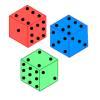Skip over navigation


Or search by topic
Number and algebra
Geometry and measure
Probability and statistics
Working mathematically
Advanced mathematics
For younger learners
Sissa's Reward
Age 11 to 14
Challenge Level 





- Problem
- Getting Started
- Student Solutions
| Try making a table with the number of the square and the number of grains of rice on that square, this way it may be easier to spot a pattern. For example: | ||||||||||||||
|
||||||||||||||
| Try to link the number in the left column to its related number
in the right column. Can you think of a general rule? You may need to use powers. |
You may also like
Square It
Players take it in turns to choose a dot on the grid. The winner is the first to have four dots that can be joined to form a square.
Non-transitive Dice
Alison and Charlie are playing a game. Charlie wants to go first so Alison lets him. Was that such a good idea?

